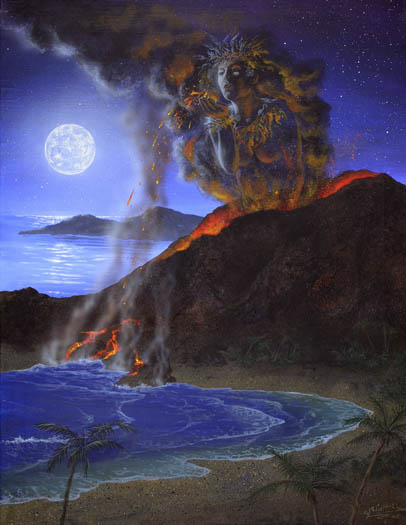Alien Volcanoes
Coming soon from Johns Hopkins University Press: Alien Volcanoes
by Michael Carroll and Rosaly Lopes (fall 2007).
These pages include excerpts and art from our upcoming book, courtesy Johns Hopkins University Press.
Over its lifetime, the planets and moons of our solar system have been pummeled by asteroids, baked by high temperatures and freeze-dried in the vacuum of space. Some worlds are blessed with their own atmospheres, which have eroded and chiseled their surfaces by winds and rains of water, sulfur or methane. But another force has changed the face of our cosmic neighbors. From Mercury to the moons of Neptune, many worlds have been molded and sculpted by volcanoes. Some of these erupting mountains are familiar to us Earthlings, looking a lot like their siblings on the island of Hawaii or the peninsula of Kamchatka. But others are entirely alien. In these few pages, we will explore the wide spectrum of alien volcanoes.
Volcanoes of the Terrestrial Worlds
The terrestrial—or rocky—planets share many things in common: a solid surface, a close proximity to the Sun, and a thin atmosphere (in the case of Mercury, almost none). Mercury, Venus, Earth and Mars all bear volcanoes driven by the heat of radioactivity deep inside them. Heat from the initial formation of these worlds, coupled with the simmering of radioactive minerals within, serves as a recipe for violent venting of internal heat in the form of erupting mountains and fountaining streams of liquid rock. The volcanoes of the outer solar system are far more alien than these nearby structures, as we will see. But to understand and appreciate the complexities of alien volcanoes, we must first look to our home world and the other terrestrial planets. We can add our own Moon to the list, as it is geologically similar in many ways to the four inner worlds.
The Earth
Long before there were people to witness them, before oceans washed across the face of planet Earth, before life took hold here, there were volcanoes. Volcanoes brought glowing energy and materials from deep within the Earth, enriching the environment and sculpting the landscape. Much of the air we breathe today comes from the atmospheric building blocks of these early eruptions. From a shore on the early Earth, volcanic lava "seas" of the Moon are visible above.
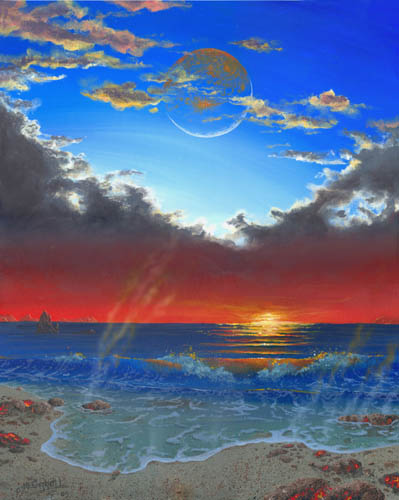
The Moon
Even with the naked eye, it is easy to see that the Moon has bright mountainous regions, called highlands or terrae, and vast expanses of dark materials, forming the lunar maria or “seas”. These were once seas of lava. One can only imagine how spectacular they must have been, when long lava flows streaked across the surface.
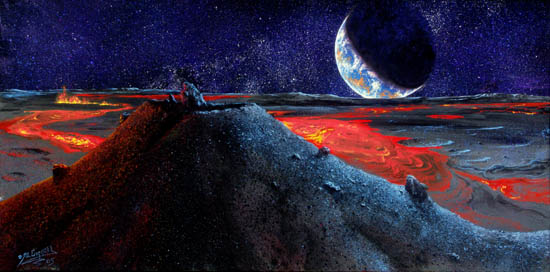
Mercury
At about the time the Moon was geologically dying, the planet Mercury was probably nearing its last throes of volcanic activity. Impact scars camouflage Mercury’s record of volcanism, but cratered surfaces actually help us to constrain timetables for Mercury’s eruptive epoch. The small planet is devoid of craters less than 50 km across, leading scientists to conclude that lavas buried anything smaller billions of years ago. We can infer volcanic activity in several areas, but the search is on for specific volcanic forms. Only about half of Mercury's globe has been imaged up close, and these resolutions were often insufficient to see smaller volcanic structures. The Messenger spacecraft, now en route to the closest planet to the Sun, will begin a series of flybys in 2008, culminating in an orbital mapping mission in 2011. Hopefully the craft will unveil a detailed record of volcanoes on Mercury. The European Space Agency is also planning a Mercury mission called BepiColumbo, slated for launch in 2012.
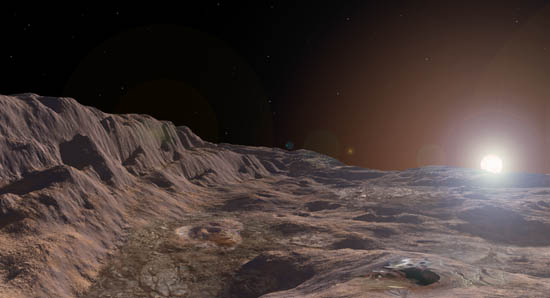
Venus
Among the terrestrial (Earth-like) worlds, Venus is Planet Volcano. Venusian real estate has more volcanic shields, domes, cones, and flows per square mile than any other lot in our solar system. Were it not for the gloomy, acid-laden yellow sky, some of its volcanic landscapes would seem familiar to any Hawaiian. Other landforms are alien beyond the imaginings of the best science fiction writers. Their bizarre nature may stem from the alien environment of Venus. Surface temperatures simmer at over 700oC (900F). Air pressure at the surface is 90 times that of Earth at sea level, something more akin to the depths of Earth’s oceans. Sulfuric acid drizzles in the lightning-laced clouds above. It’s not a great place for a picnic. We think of the planet as a lifeless wasteland, but scientists have charted a veritable volcanic menagerie there. This zoo includes ticks, anemones, and arachnoids. They’ve even located a few pancakes…and they’re big ones. These whimsical names were assigned informally by researchers who first studied the returned radar images from the Magellan Mission to Venus. As they are Venusian, it is not surprising that they all appear to be related to volcanism.
Foundational to this wildlife collection are the “pancake domes.” These eerie formations are roughly disk-shaped and flat to slightly domed on top. They average fifteen miles in diameter and 2500 feet in height.
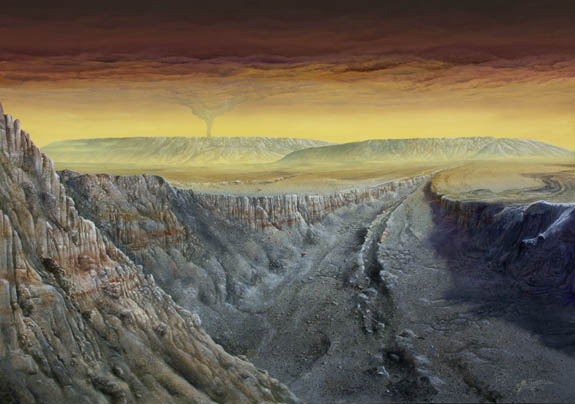
Mars
Geologists separate Martian history into three eras: Noachian (the oldest, from the planet’s formation up until roughly 3500 million years ago), Hesperian (from 3500 to 1800 million years ago) and Amazonian, which reaches into the present. Near the Hellas Basin, Tyrrhena Patera is thought to have first erupted roughly 3000 million years ago, and probably continued activity into the early Amazonian period, up to 1600 million years in the past. Did something trigger the first volcanism on Mars in the Hesperian Period? Undoubtedly, there were volcanoes from Mars’ earliest formative periods. Their existence has been all but obliterated by meteor impacts and relentless winds. Studies of the rare Noachian areas still preserved show subtle evidence of volcanism, and it has been suggested that Martian volcanism was ten times as fierce then as during the Hesperian. But volcanic styles have changed over time. It is likely that the earliest Martian environments were wetter than conditions today. Water makes for more ash than lava, and ash-built structures tend to weather away faster than rugged lava mountains. The large shields or other volcanoes that did build up tended to sink into the crust under their own weight. This fact tells us that the shields of Tharsis and Elysium are fairly recent, with their activity continuing into the Amazonian. In fact, some flows on the Tharsis shields could have been laid down within the last ten million years – very recent in geologic terms!In this painting, a Martian volcano triggers a flash flood. Freezing water vapor forms an ice halo around the distant sun.
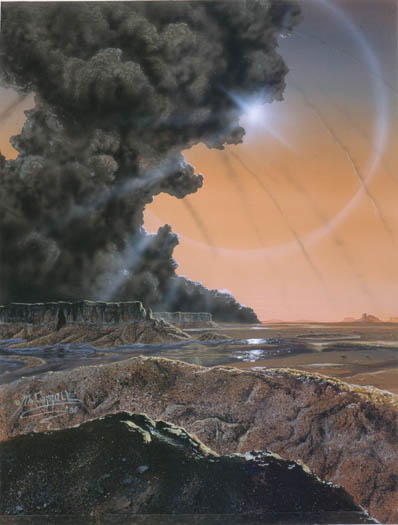
Volcanoes of the Outer Solar System
Jupiter's moon Io
In his Inferno, the 14th century poet, Dante Alighieri, envisioned Hell as a world of belching fire, billowing smoke, sulfurous fumes, and tortured landscapes, with a great frozen sea at the center.
Dante’s vision of Hell is remarkably similar to a real world 63 million kilometers from here. This Dante-esque panorama is Io, the innermost of Jupiter’s four largest moons. Here, lava gushes like searing oil across multi-colored plains. Geyser-like plumes rocket 500 km into the airless sky, raining down a deadly hail of frozen sulfur. Mountains thrust out of the ochre plains like icebergs from an arctic ocean, towering above red, yellow and white blankets of sulfur. Fountains of lava explode from cracks a dozen miles long. Snowy sulfur dioxide frosts rocks and valleys, contrasting with strange greenish areas which planetary scientists have nicknamed “golf courses.” The volcanoes that sculpt the Ionian landscape are some of the most alien in our solar system. Io is a strange realm indeed, and one that continues to challenge the best scientific minds of our time. This painting shows us the volcanic crater known as Tupan Caldera. (Painting from the collection of Rosaly Lopes)
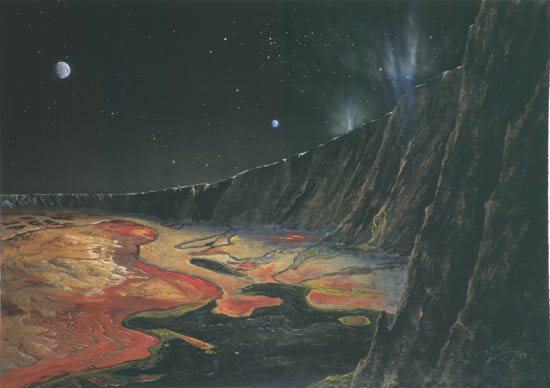
"Cryovolcanism" and Jupiter's Moon Europa
While the volcanoes of the inner solar system and Io are forged in the furnaces of molten rock, magma is not the only recipe for volcanic eruptions. Alien brews are simmering out there. Frigid gases escape from Triton and Enceladus. Other strange concoctions are birthing eruptions of a very different kind, powered by “magma” of exotic chemistry: super-chilled water mixed with ammonia, methanol, and other strange mixtures. These alien eruptions are called cryovolcanism.
On Jupiter's icy moon Europa, material appears to be staining the surface ice from beneath. The amorphous, often radial discoloration may be the fallout from geyser-like activity. Such stained sites are called “painted terrain”. Many such features exist on Europa. Most are associated with fractures or faults.
Cryovolcanism may also be exhibited in ponded and flooded areas. “Cryolavas” appear to have erupted or seeped onto the surface leaving frozen pools. These smooth areas embay low-lying terrain, oozing into adjacent valleys and troughs before freezing solid. The erupted material is darker than the surrounding landscape and may be the expression of briny subsurface lakes. Given Europa’s orbital stresses, many planetary geologists believe it likely that Europa’s ocean floor is pockmarked by volcanic vents. If current models are correct, those vents are submerged by as much as 120 kilometers of water. The great distance might preclude any direct disruption of the surface, so Europa may not exhibit any visible clues about seafloor volcanism. Still, there are mysterious features hinting at forces beneath the crust. The most striking of there are the chaotic regions. Here, ridges are seen to slip across each other in lateral faults, while remnants of ridged ground have broken and rotated in a slush of debris. Chaotic terrains bear a striking similarity to sea ice in arctic regions. In the terrestrial case, solid ice has fractured, drifted into new positions, and been frozen in place again. In this painting, we see a fresh impact crater which has filled with water, then flash-frozen in the cold vacuum of the Europan environment.
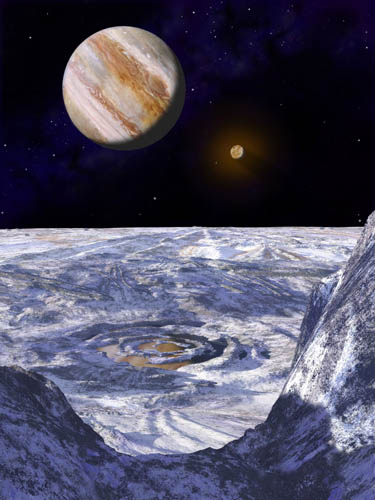
Saturn's planet-moon, Titan
Saturn’s largest moon is one of the most exotic and mysterious bodies of the Solar System. Discovered in 1655 by Dutch astronomer Christiaan Huygens, Titan guarded its secrets well until the Cassini mission arrived to orbit Saturn in 2004. Titan has the second densest atmosphere of any of the solid bodies we know, second only to Venus. This atmosphere shrouded the moon, completely veiling its surface until Cassini viewed it through special camera and radar systems. The European Space Agency also mounted a successful—and spectacular—mission to the Titan surface with its probe Huygens.
Some researchers predicted that Titan's surface would display cryovolcanic flows, and perhaps domes similar to the “pancake” domes on Venus. Cassini results suggest that cryovolcanism has indeed been a significant geologic process on Titan and may be a major contributor to the atmospheric methane. On October, 2004, Cassini executed its first targeted fly-by of Titan, turning on the radar instrument in its SAR (Synthetic Aperture Radar) mode to obtain images at spatial resolution of about 350 meters, covering about 1% of Titan’s surface. The most prominent feature revealed in these radar images was a circular feature interpreted to be a cryovolcanic dome and later named Ganesa (after the Hindu god of good fortune). Ganesa is about 180 km in diameter, so it is larger than the domes on Venus. It could be a shield rather than dome, since we do not yet have topographic information over this feature, we cannot know for sure.
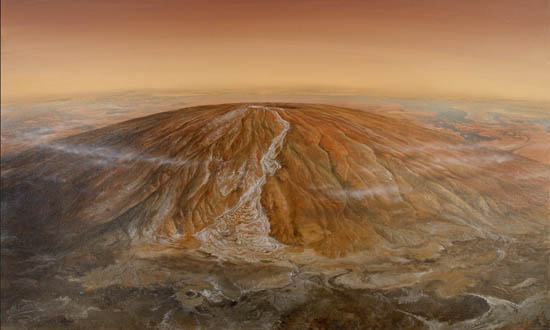
Saturn's Remarkable Exploding Moon Enceladus
Scientists knew that Saturn's tenuous E ring was being continually replenished from an unknown source. They were also aware that the tiny moon Enceladus orbited within the ring, and many suspected that the ring's fine particles emanated from the moon itself. Enceladus is a strange world. Its pristine ice surface is, in places, a tortured jumble of twisted ridges and cracked plains nearly devoid of craters. These plains appeared to have been resurfaced, yielding a relatively young geological age of less than 200 million years. Other parts of the surface are heavily cratered. All surfaces of Enceladus—ancient or young—had very high albedo, suggesting that the entire moon is dusted with fresh material.
A scant 504 km across, its diameter would cover the country of Spain. Because of its diminutive size, Enceladus' geologically young surface was mystifying. Nearby saturnian moons exhibited far less geological activity on their surfaces, despite the fact that many are larger. The orbital eccentricity of Enceladus is comparable to that of Io, so researchers assumed that tidal forces might be strong enough to trigger some kind of activity.
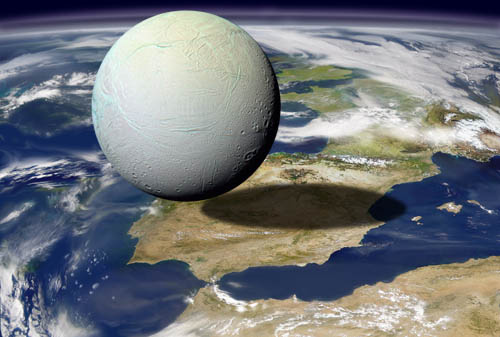
Positive identification of cryovolcanic activity on Enceladus came from a trio of Cassini flybys spanning February to July of 2005. The craft's first two encounters revealed much circumstantial evidence that water was leaking from the tiny moon. For the third flyby, Cassini's orbit was modified. Its new course carried the craft within 168 km of the surface on July 14, 2005. Cassini was able to fly directly through an extended plume of material. The spacecraft detected water vapor, carbon dioxide, methane, trace amounts of acetylene and propane, and possibly carbon monoxide and molecular nitrogen.
Active geyser-like phenomena were confirmed visually by Cassini's imaging science subsystem. Multiple jets of icy material were imaged. The plumes appear to emanate from a series of canyons and ridges which border a flat region in the southern hemisphere. The bizarre terrain, extending across an area at roughly 55º south latitude, is a geologically young surface scored by parallel tectonic rifts. These rifts encircle four darkened troughs, called "tiger stripes". The rifts are 500 meters deep, bracketed by 100 meter high ridges. Each is about 2 kilometers across, and up to 130 kilometers in length. Dark material extends several kilometers to each side, and is apparently erupting or seeping from the rifts.
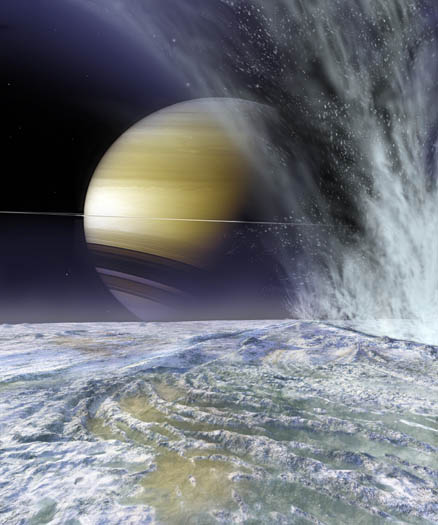
Even more Alien Volcanoes on Neptune's Moon Triton
Triton is the most distant and the coldest moon so far visited by a spacecraft, and one might think it an unlikely place for volcanic activity. Triton was Voyager 2’s last stop before it went on its way to the outer edges of the Solar System and beyond. Voyager 2 flew above Triton’s south pole on August 25, 1989, taking stereo images that showed two dark, tall plumes, reaching about 8 km above the surface and leaving trails for about 150 km. Other images of Triton's southern polar region revealed more than 100 dark, streaky deposits, presumably a result of other plumes, implying that plume activity must be fairly common. We don’t know how widespread plume activity is on Triton, as the northern polar regions were in darkness during the Voyager fly-by. At lower latitudes, images showed a peculiar terrain with flow-like features, probably resulting from cryovolcanic flooding of older topography. This terrain has been dubbed “cantaloupe” because of its resemblance to the skin of the melon.
Cryovolcanism on Triton is very different from cryovolcanism on the satellites of Jupiter and Saturn. Water ice is likely to be present in the crust, but it has not yet been detected. Triton has a very thin atmosphere made up largely of nitrogen. The atmosphere transports nitrogen ice from pole to pole every Triton year, keeping the surface temperature nearly the same everywhere.
The active plumes spied by Voyager are thought to be similar to geysers, caused by solar sublimation of the polar cap. One model explains the plumes as the result of sunlight beating down on and penetrating a transparent layer of nitrogen ice. This process has a terrestrial analogue that has been prevalent in the press lately: the greenhouse effect. As it turns out, the greenhouse effect is not limited to particle-clogged atmospheres. It can sometimes operate within a solid, especially when that solid is nitrogen ice. Nitrogen ice is very clear, so sunlight can penetrate deep into the ice, creating a "solid-state greenhouse effect". Sunlight is absorbed and trapped by dark, carbon-rich impurities a few meters below the surface. This mild heating is enough to cause the interior of the nitrogen ice to become gas. The expanding gas then explodes into the near-vacuum of Triton's environment. If this model is correct, cryovolcanism on Triton is a side-effect of sunlight, rather than an internally-driven phenomenon. It is likely that Triton came from the Kuiper Belt and is perhaps a similar world to Pluto.
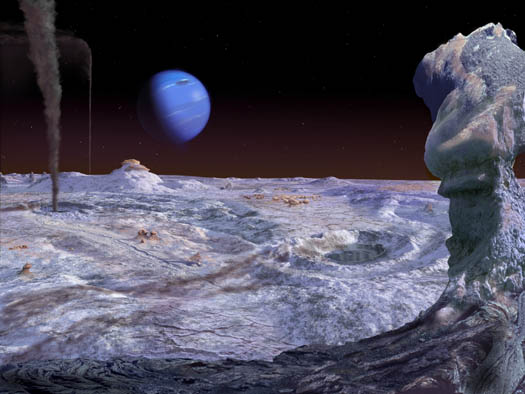
Volcanoes and Culture
Tolkein gave us Mount Doom, with its thundering clouds and exploding fireballs. Jules Verne took us down the very throat of Mt. Snaefels to get to another world. There is something in the nature of volcanoes that touches a visceral level in us all, something primordial and elemental. Now, we have seen erupting summits beyond our home world, and that elemental experience is stirred again in new ways. But always, alien volcanoes remind us of our roots, echoed in the spirit of Madame Pele, who is tied to the volcanoes of Hawaii.
